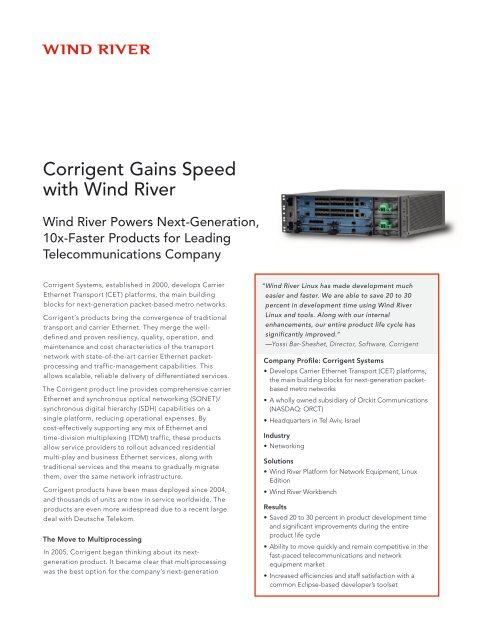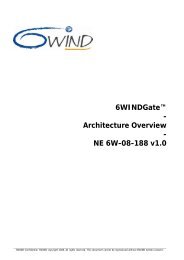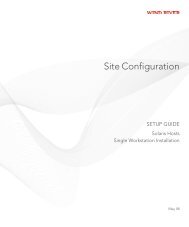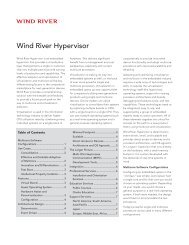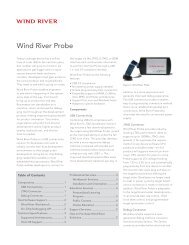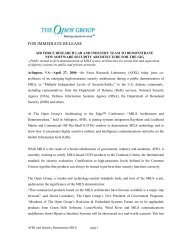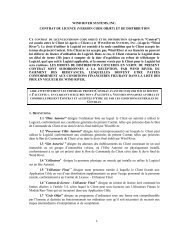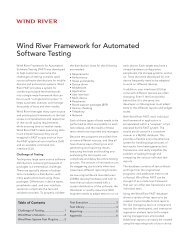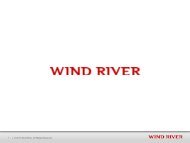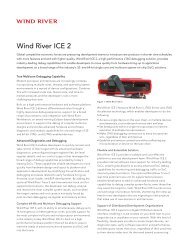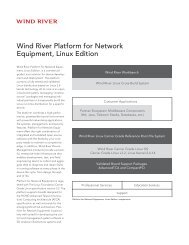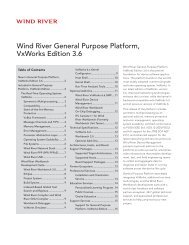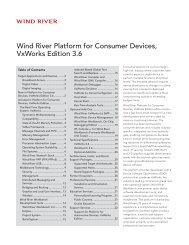National Instruments: Unified Graphical System Design ... - Wind River
National Instruments: Unified Graphical System Design ... - Wind River
National Instruments: Unified Graphical System Design ... - Wind River
You also want an ePaper? Increase the reach of your titles
YUMPU automatically turns print PDFs into web optimized ePapers that Google loves.
Corrigent Gains Speed<br />
with <strong>Wind</strong> <strong>River</strong><br />
<strong>Wind</strong> <strong>River</strong> Powers Next-Generation,<br />
10x-Faster Products for Leading<br />
Telecommunications Company<br />
Corrigent <strong>System</strong>s, established in 2000, develops Carrier<br />
Ethernet Transport (CET) platforms, the main building<br />
blocks for next-generation packet-based metro networks.<br />
Corrigent’s products bring the convergence of traditional<br />
transport and carrier Ethernet. They merge the well-<br />
defined and proven resiliency, quality, operation, and<br />
maintenance and cost characteristics of the transport<br />
network with state-of-the-art carrier Ethernet packet-<br />
processing and traffic-management capabilities. This<br />
allows scalable, reliable delivery of differentiated services.<br />
The Corrigent product line provides comprehensive carrier<br />
Ethernet and synchronous optical networking (SONET)/<br />
synchronous digital hierarchy (SDH) capabilities on a<br />
single platform, reducing operational expenses. By<br />
cost-effectively supporting any mix of Ethernet and<br />
time-division multiplexing (TDM) traffic, these products<br />
allow service providers to rollout advanced residential<br />
multi-play and business Ethernet services, along with<br />
traditional services and the means to gradually migrate<br />
them, over the same network infrastructure.<br />
Corrigent products have been mass deployed since 2004,<br />
and thousands of units are now in service worldwide. The<br />
products are even more widespread due to a recent large<br />
deal with Deutsche Telekom.<br />
The Move to Multiprocessing<br />
In 2005, Corrigent began thinking about its next-<br />
generation product. It became clear that multiprocessing<br />
was the best option for the company’s next-generation<br />
“<strong>Wind</strong> <strong>River</strong> Linux has made development much<br />
easier and faster. We are able to save 20 to 30<br />
percent in development time using <strong>Wind</strong> <strong>River</strong><br />
Linux and tools. Along with our internal<br />
enhancements, our entire product life cycle has<br />
significantly improved.”<br />
— Yossi Bar-Sheshet, Director, Software, Corrigent<br />
Company Profile: Corrigent <strong>System</strong>s<br />
• Develops Carrier Ethernet Transport (CET) platforms,<br />
the main building blocks for next-generation packetbased<br />
metro networks<br />
• A wholly owned subsidiary of Orckit Communications<br />
(NASDAQ: ORCT)<br />
• Headquarters in Tel Aviv, Israel<br />
Industry<br />
• Networking<br />
Solutions<br />
• <strong>Wind</strong> <strong>River</strong> Platform for Network Equipment, Linux<br />
Edition<br />
• <strong>Wind</strong> <strong>River</strong> Workbench<br />
Results<br />
• Saved 20 to 30 percent in product development time<br />
and significant improvements during the entire<br />
product life cycle<br />
• Ability to move quickly and remain competitive in the<br />
fast-paced telecommunications and network<br />
equipment market<br />
• Increased efficiencies and staff satisfaction with a<br />
common Eclipse-based developer’s toolset
CM 4000-series CET switch, based on a distributed data<br />
architecture and more than 10 times faster than its first-<br />
generation legacy product. The CM 4000 would provide a<br />
non-blocking switching capacity of 320 Gbps and other<br />
improvements compared to the legacy product.<br />
The engineering team needed to create an entirely new<br />
architecture to deliver this robust product. The software<br />
research and development team members conducted<br />
market research, talking to customers and peers about the<br />
ideal operating system to meet Corrigent’s rigorous needs.<br />
“When we started to investigate, we found there was a big<br />
wave of enthusiasm about open source,” recalls Yossi<br />
Bar-Sheshet, Director, Software. “We understood that most<br />
of the telecommunications market was going toward Linux<br />
because of its stability and efficiency. All the big players<br />
were going in this direction, and it made sense for us as well.”<br />
Once Corrigent decided a Carrier Grade Linux operating<br />
system (OS) was the right fit for the CM-4000 series, the<br />
company zeroed in on <strong>Wind</strong> <strong>River</strong> Linux and Monta Vista<br />
Linux.<br />
“It’s a daily challenge to produce products fast enough<br />
to make the market window without sacrificing our<br />
high-quality standards. We work in a very complicated,<br />
risky market space—and <strong>Wind</strong> <strong>River</strong> helps us navigate<br />
the challenges and succeed.”<br />
—Yossi Bar-Sheshet, Director, Software, Corrigent<br />
“We initially leaned toward <strong>Wind</strong> <strong>River</strong> because the most<br />
important issue to me, as a manager, was the development<br />
environment,” Yossi says. “We have dozens of engineers and<br />
we needed a stable, collaborative environment. We were<br />
looking for a stable Linux distribution and we needed the<br />
right tools and the right support. Monta Vista just provided<br />
Eclipse as its IDE without any other tools or amendments.”<br />
<strong>Wind</strong> <strong>River</strong> offered a Linux platform—<strong>Wind</strong> <strong>River</strong> Platform for<br />
Network Equipment, Linux Edition—tailored to the telecommunications<br />
and network equipment and marketplace. <strong>Wind</strong><br />
<strong>River</strong> also offered a full Eclipse-based developer toolset,<br />
<strong>Wind</strong> <strong>River</strong> Workbench, and readily available support in<br />
Europe and the Middle East.<br />
<strong>Wind</strong> <strong>River</strong> Offers Speed, Efficiency<br />
While Corrigent was confident in its decision to move to<br />
<strong>Wind</strong> <strong>River</strong> Linux, it still faced challenges during the move<br />
from a real-time operating system (RTOS)-based, multitasking<br />
architecture to multiprocessing.<br />
The transition was eased by <strong>Wind</strong> <strong>River</strong> tools such as kernel<br />
debugging tools and multithreading debug capabilities,<br />
which offered a whole new level of convenience to Yossi’s<br />
team. The team found the hardware bring-up process much<br />
easier with <strong>Wind</strong> <strong>River</strong> Linux and available networking<br />
libraries.<br />
As a manager, Yossi used to hear complaints when a<br />
problem arises. But since his team has used <strong>Wind</strong> <strong>River</strong> Linux<br />
and <strong>Wind</strong> <strong>River</strong> Workbench, his job has become easier in this<br />
regard.<br />
“There are no complaints from my engineers about <strong>Wind</strong><br />
<strong>River</strong> Linux and the <strong>Wind</strong> <strong>River</strong> Workbench environment,”<br />
Yossi says. “Using <strong>Wind</strong> <strong>River</strong> Platform for Network Equipment,<br />
Linux Edition prevents us from making many mistakes.”<br />
As Corrigent navigates the increasingly competitive telecommunications<br />
marketplace, Yossi considers <strong>Wind</strong> <strong>River</strong> a<br />
critical vendor.<br />
“As a carrier-grade company that’s still considered a startup,<br />
we have a lot of pressure to provide new products quickly,”<br />
Yossi concludes. “It’s a daily challenge to produce products<br />
fast enough to make the market window without sacrificing<br />
our high-quality standards. We work in a very complicated,<br />
risky market space—and <strong>Wind</strong> <strong>River</strong> helps us navigate the<br />
challenges and succeed.”<br />
Learn More<br />
For additional information about the products mentioned in<br />
this case study, visit:<br />
www.windriver.com<br />
www.corrigent.com<br />
<strong>Wind</strong> <strong>River</strong> is the global leader in Device Software Optimization (DSO). We enable companies to develop,<br />
run, and manage device software faster, better, at lower cost, and more reliably. www.windriver.com<br />
© 2009 <strong>Wind</strong> <strong>River</strong> <strong>System</strong>s, Inc. The <strong>Wind</strong> <strong>River</strong> logo is a trademark of <strong>Wind</strong> <strong>River</strong> <strong>System</strong>s, Inc., and <strong>Wind</strong> <strong>River</strong> and VxWorks are registered trademarks of <strong>Wind</strong> <strong>River</strong> <strong>System</strong>s, Inc.<br />
Other marks used herein are the property of their respective owners. For more information, see www.windriver.com/company/terms/trademark.html. Rev. 01/2009


